
While living here, Dali tried his hand in fashion and furniture design as well as theatre and film set decoration. In 1934, Dali made his first trip to the United States by visiting New York where some of his works were exhibited and well-received, including his most famous painting, Persistence of Memory (1931).ĭali and Gala moved to America as World War II took over Europe. Despite being expelled from school, Dali had already created a name for himself and established his characteristic and recognizable style. He even got to meet Picasso on one of his numerous visits to Paris, where he later lived and met his wife, Gala. Petersburg, Florida, which holds the largest collection of his work outside of Europe.Īs one of surrealism's most famous figures, Salvador Dali not only painted but also did sculpture, film, and photography.Īs an iconic figure and cultural icon known for his eccentricities, recognizable mustache and his work in various mediums and industries, Salvador Dali and his influence is still felt today.īorn in Figueres, Spain, Dali moved to Madrid for his studies. The Disintegration of the Persistence of Memory is now in Florida’s Salvador Dalí Museum.Originally featured in the Carstairs Gallery in New York, the painting can now be found in the Salvador Dali Museum in St. The painting represents a farewell to Dali’s interest in surrealism as he turned more and more to the contradictions and strangeness of nuclear physics. The painting was allegedly inspired by Dali’s fascination with nuclear physics, and in its own way depicts the quantum world, where things both come together and come apart at the same moment and flicker in and out of existence. A fish seems to hold up the reflection of the cliffs as it swims, unconcerned, through the water. Yet another melted watch has sunk beneath the layer of bricks, leaving bits of detritus behind. The stem and twigs, though severed from each other, float in space as if they are still connected.īeneath the surface of the water, another watch is coming to pieces over a bleached version of the creature seen in The Persistence of Memory. Some bricks furl up into darts that seem to bedevil a melting watch that is beneath the water and the melting watch that hangs from a twig of the branch in the foreground. This wall in turn begins to disintegrate as it spreads leftward. The bottom half of the picture is dominated by bricks that float in orderly rows both under and over the water and form a sort of mortarless wall on the left side of the painting. The water is clear and calm enough to mirror the cliffs in the distance, even as it bisects the one jutting rock in its center.
Salvador dali the persistence of memory meaning skin#
In this painting, the arid landscape of The Persistence of Memory has been flooded, even though the skin of the water is snagged by the leafless branch in the background. If anything, it’s even more fascinating and mysterious than The Persistence of Memory.

This oil on canvas painting, created in 1954, is only 10 by 13 inches, only slightly larger than a sheet of legal sized paper. The Disintegration of the Persistence of Memory is the companion of The Persistence of Memory, the painting that everyone knows with its pocket watches melting away in a wasteland.

The Discovery of America by Christopher Columbus, 1959 The Disintegration of the Persistence of Memory, 1952-1954 The Disintegration of the Persistence of Memory


 0 kommentar(er)
0 kommentar(er)
